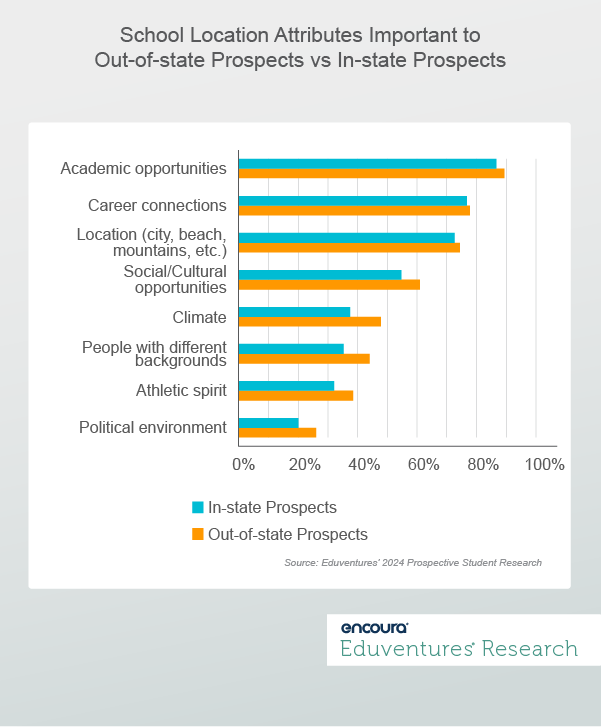Today, as many states hold primary elections, we reflect on how politics influences higher education. Political division on campus is reaching the highest levels at the most selective institutions—just ask former Harvard president Claudine Gay.
In 2018, the Pew Research Center found that 79% of Republicans agreed that professors bring their political and social views into the classroom compared to 17% of Democrats. These views have since turned into legislation in some states including Florida, which has curbed the autonomy of state colleges and universities.
But what about prospective students? As competition for out-of-state students picks up, colleges question how much the political environment discourages out-of-state applicants. How much do prospects care about politics?
Location, Location, Location
According to Eduventures’ 2024 Prospective Student Research™, 48% of high school students are interested in attending an out-of-state institution. Figure 1 shows which attributes are important to these students as they consider their options.
Figure 1.
Figure 1 shows that both in-state and out-of-state prospects care, first and foremost, about academic opportunities and outcomes when considering their location options. This is followed by career connections.
After that, both types of students look for specific location features, such as being near the beach or a warm climate. The political environment can be found toward the bottom of the priority list: 26% of out-of-state prospects say this is important to them compared to 20% of in-state prospects.
Location Appeal Lies in the Eyes of the Beholder
Still, this means that about a quarter of out-of-state students are paying attention to local politics when it comes to school selection. These students tend to be less often first-generation students and report higher household incomes and GPAs. They are more often White and are more likely to live in blue states or swing states than those who do not care about the political environment (based on the 2020 presidential election).
Which states are these politically-minded students crossing off their lists, and what locations are most appealing? Table 1 lists the top 10 states these students would be most and least likely to consider attending out-of-state.
Top 10 Most and Least Desired States Students Would Consider as Out-of-state Destinations
(Among out-of-state prospects who indicate they care about the political environment of the campus.)
| Most Desired Out-of-state Locations | Least Desired Out-of-state Locations |
|---|---|
| 1. New York | 1. Alabama |
| 2. Massachusetts | 2. Florida |
| 3. California | 3. Alaska |
| 4. North Carolina | 4. New York |
| 5. Pennsylvania | 5. Texas |
| 6. Texas | 6. California |
| 7. Colorado | 7. Ohio |
| 8. Florida | 8. New Mexico |
| 9. Virginia | 9. Mississippi |
| 10. Georgia | 10. Hawaii |
Table 1.
This shows that the top three most desirable states are historically blue states while the top three least desirable states are historically red states. Further down the lists, however, both red and blue states appear on both lists.
The top states that appear on both lists are New York, California, Texas, and Florida. This shows that states like Florida, where politics have a strong influence on higher education, indeed deter some out-of-state prospects who care about the political climate. But they also attract other students, perhaps for different reasons.
Those who list Florida among their top considerations more often choose “athletic spirit” as an important factor in addition to the political environment. Alternatively, those who regard Florida as least desirable more often want to be around people with different backgrounds. This reinforces the idea that politics doesn’t tell the whole story, even among those who care about it.
There are also regional differences. For example, the top three destinations among Florida students are New York (the national favorite), North Carolina, and Georgia. New York can also be found among the least desirable states for Florida students. Beyond New York, Florida students show a preference for states closer to home. This pattern can be seen more broadly across the country as well—many students consider attending college in a neighboring state or nearby.
The most recent National Center for Education Statistics (NCES) data on student migration confirms that neighboring states are indeed the top destination for out-of-state students. For instance, in 2022, Florida students headed out-of-state most often enrolled in Georgia (11% of all out-of-state FL students) and Alabama (9%), with New York (8%) only as the third-most popular destination.
This tracks with migration patterns that can be observed in NCES data. In other words, actual out-of-state enrollment largely happens within regions—students usually don’t stray too far from home.
The Bottom Line
The good news is that the political climate is not the top consideration of students who are interested in out-of-state schools. Like in-state prospects, these students are most concerned with key application drivers: perceived academic and career opportunities.
But some students do care about the local political climate – although many of these will still behave like the average out-of-state prospect and choose to stay close to home.
Out-of-state preferences are complex, and you can’t please everyone. But you can try to offer a campus environment that encourages diversity of opinions. What all students have in common is the desire for safety and belonging.


